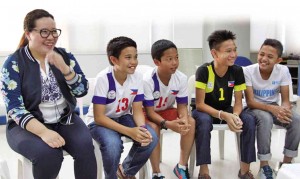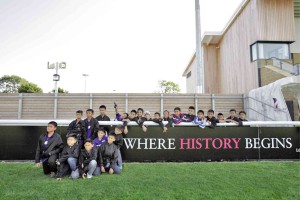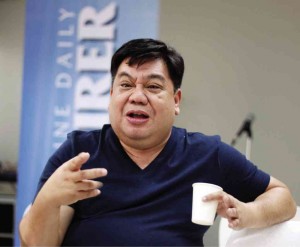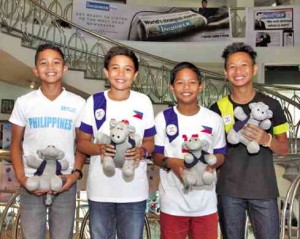Little heroes, big dreams
Screenings of indie films at the Inquirer have gone on for eight years but, for the first time, with Baby Ruth Villarama’s “Little Azkals,” viewers as young as the documentary’s pint-sized heroes turned up.
The acclaimed docu follows 22 Filipino boys from across the country, ages 10 and 11, who traveled to the United Kingdom for a three-week “elite” football training program at the Loughborough University in the summer of 2013.

FILMMAKER Baby Ruth Villarama with the boys (from left) Robert Orr, Jacob Pedernal, Nikko Gutierrez and Nicolai Abalos Kimberly de la Cruz
Present at the Inquirer screening were Villarama, producer Albert Almendralejo, editor-producer Chuck Gutierrez, coach and former Azkals player Emelio “Chieffy” Caligdong, consultant Alec Ladanga, and four Little Azkals—Jacob Pedernal, Nicolai Abalos, Nikko Gutierrez and Robert Orr.
Guardians Nerissa M. Abalos, Mei Pedernal and Liza G. Orr were present, too, and watched the docu for the nth time. They didn’t mind. As one of them said, “It never gets old.”
Indeed, the docu has all the ingredients for riveting viewing: drama, comedy, suspense, travelogue, even a little show biz intrigue via an inquisitive Little Azkal who asks Phil Younghusband about ex-GF Angel Locsin.
The kids in the audience cheered every goal that the Little Azkals score onscreen, and a few soccer moms teared up in parts where the athletes struggle with homesickness.
This summer, the boys’ journey continues. After a weekend engagement at SM Cinemas last October, the docu, “Little Azkals: Pursuit of a World Cup Dream” is having its free TV premiere April 12, 10:30 p.m. on ABS-CBN.
The kids’ UK training was made possible with the support of The British Council, the Philippine Football Federation (PFF), Pru Life UK Philippines and Voyage Films.
Baby Ruth, were you a football fan before this?

TWENTY-TWO Filipino kids underwent an elite program at Britain’s Loughborough University, which trains Olympic athletes.
Baby Ruth Villarama: Not really. But in the UK, I realized how hard the training really was. The kids face a tremendous [challenge] to be future national team players. Much is expected of them. We hope our film does justice to these kids’ sacrifices. Once back home, I began to study football seriously.
Do you keep abreast of their journey?
BRV: We try to attend the tryouts. We’ve formed a Facebook group so we can follow their progress. Chuck now supports teams in Visayas and Mindanao.
How did you get involved, in the first place?
BRV: It was actually Albert’s baby… with (creative producer) Doy del Mundo.
Albert Almendralejo: Doy suggested Baby Ruth [as director]. She was abroad at the time; I met with her husband (Chuck), a football fan. He committed her to the project.
BRV: I was in Africa for another film. Chuck called—his selling point was: Do you want to go to the UK? Sure! Once there, I realized it was hard work.
AA: We had to do this docu to raise funds. The British Council gave us a grant, but we need counterpart funding. Sadly, the PFF has no money. We’re counting on proceeds from the TV airing.
The UK trip isn’t fully paid?
AA: I signed the contract with the British Council. I will end up in jail if we fail to pay up (laughs)!
Is a sequel in the works?
BRV: Yes, it will be called “The Boy With No Shoes.” We are following one of the players, Agiel John “Kano” Rojo. He’s very interesting. He comes from a family of athletes. By 2019, we hope to have produced yet another, in time for the U-17 (under 17 years old) tryouts.
How many times did you cry while making the film?
BRV: Lots. Even now, when we watch it, we recall those hectic, cold days in the UK.
Kids, how many times have you seen the film?
Robert Orr: Five times. I am very proud to be part of it.
Nicolai Abalos: Three. I am happy I made new friends through the movie.
Jacob Pedernal: Seven. It always brings back good memories. I still can’t believe I am in a movie.
Nikko Gutierrez: Maybe 10 times. I used to get embarrassed seeing myself onscreen, but I’ve gotten used to it. Every one of us has grown up.
Who got the most homesick?
AA: Nicolai. He spent his birth anniversary in the UK. He didn’t tell anyone. But we found out, so we surprised him with a gift. We saw that his shoes were already worn. Everyone, including the kids, pitched in for a new pair.
BRV: A lot of them went to the UK with incomplete equipment. A few hours before the flight, we learned Kano didn’t have training shoes. We rushed to SM Megamall.
How did it feel to be followed around by a camera for three weeks?
RO: When there was a camera, I tried not to screw up. Once, during training, I messed up. I told the cameraman: Don’t put that in. Can we reshoot?
NG: It was best not to mind the camera.

ALBERT Almendralejo commends the parents for supporting the boys’ World Cup dream. KIMBERLY DE LA CRUZ
NA: I got nervous. I thought, it would be embarrassing to make a mistake.
JP: It was hard to do our job properly.
RO: In the end, it was best to just be ourselves, act natural.
No one felt like a rock star?
JP: Kano and Shane (Niel Clemente) were the rock stars. They hogged the cameras.
Did anyone end up fighting?
AA: Kano and Michael (Osorio). They were the youngest.
One kid was shown crying.
BRV: That was Shane.
JP: He lost a shirt that his mom gave him.
BRV: He eventually found it. He cried out of sheer exhaustion and frustration. That started the ball rolling. By the second week, they were all homesick and crying.
AA: Each kid had a room to himself, a bedroom with its own kitchen and refrigerator. Filipino kids are not used to that; they prefer sharing rooms with parents and siblings. Some of the kids ended up in other rooms, sleeping over.

FOUR of the boys, reunited at the Inquirer (holding Guyitos, from left): Nicolai Abalos, Robert Orr, Jacob Pedernal, Nikko Gutierrez Kimberly de la Cruz
How did you find British food?
AA: Nikko put a lot of salt on his food.
RO: We got used to it. It was filling, but bland.
AA: They loved it every time Filipinos living nearby visited us, bringing adobo, kare-kare, instant noodles, rice!
How did the Filipinos find you?
BRV: We didn’t expect there would be Filipinos in Loughborough (two and a half hours by bus from London). A Filipino working in the university saw us. It took just that one for word to get around.
The docu shows how well-supported athletes are in the UK, starting with food.
BRV: That’s what we wanted to show in the ending.
But Kano had unlimited rice.
BRV: One huge basin.
AA: Plus candy as dessert! The docu ending shows the sleeping quarters of Palarong Pambansa players: A classroom with small beds—it looks like an evacuation center.
BRV: Our athletes always look for rice when they are abroad. It is the source of their power.
Do you see the kids playing together again?
AA: That’s the sad part. They had to go back to their respective provinces. Tryouts for the U-14, national team, are ongoing. All of them will try out. I think a number of them will make it. We don’t know what comes next … The boys need to keep improving. There is a conscious effort to take care of them but it’s a private-sector initiative, not government’s.
What is the ultimate goal?
AA: Our dream is in 2019, the Philippines will compete in the U-17 World Cup with a fully homegrown team. As of now, only three of the Azkals are homegrown: Amani Aguinaldo, Ruben Doctora Jr. and Patrick Deyto. Most others are based or trained abroad. Of course we hope the country makes it to the World Cup someday soon. It’s a pipe dream for now. But we have to start somewhere. As the Loughborough University motto puts it: History begins here.
